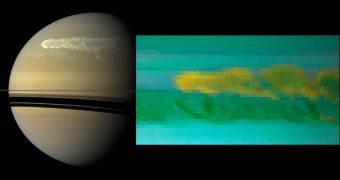People have been staring at Saturn for hundreds of years and for good reason, it's gorgeous. Today, we have a powerful probe, Cassini, orbiting it and its moons. The probe has been there for almost a decade.
Yet, there's still a lot we don't know about the planet, particularly about its interior. The thick atmosphere means we can only "see" the makeup of the top layer. But every once in a while, a massive storm brings up material from the lower layers, making it visible to astronomers.
One such monster storm, the type of which only happens once every 30 years, or once every Saturn year, has been raging on the planet for the past few years, stirring up the atmosphere, though it has mostly settled by now.
The storm presented a great opportunity for Cassini to make observations about the lower layers of the atmosphere.
The results of those observations have been published in the journal Icarus this month. The storm brought up particles of ice water and ice ammonia as well as a third component which could possibly be ammonia hydrosulphide.
The data isn't enough to determine whether clouds made of these different materials sit side by side or whether cloud particles are made up of a mixture of the three components.
"We think this huge thunderstorm is driving these cloud particles upward, sort of like a volcano bringing up material from the depths and making it visible from outside the atmosphere," Lawrence Sromovsky of the University of Wisconsin-Madison, who led the study, said.
"The upper haze is so optically thick that it is only in the stormy regions where the haze is penetrated by powerful updrafts that you can see evidence for the ammonia ice and the water ice. Those storm particles have an infrared color signature that is very different from the haze particles in the surrounding atmosphere" he added.

 14 DAY TRIAL //
14 DAY TRIAL //